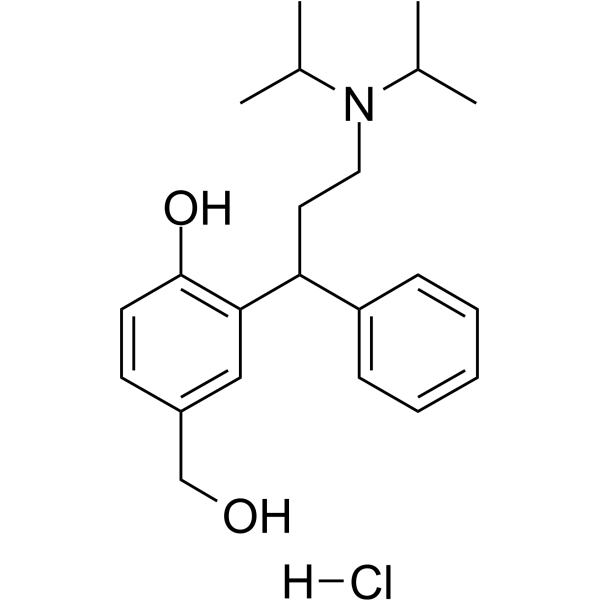(Rac)-5-Hydroxymethyl Tolterodine hydrochloride |
| Catalog No.GC71582 |
(Rac)-5-Hydroxymethyl Tolterodine ((Rac)-Desfesoterodine) hydrochloride, an active metabolite of Tolterodine, is a mAChR antagonist (Ki values of 2.3 nM, 2 nM, 2.5 nM, 2.8 nM, and 2.9 nM for M1, M2, M3, M4, and M5 receptors, respectively).
Products are for research use only. Not for human use. We do not sell to patients.

Cas No.: 250214-40-5
Sample solution is provided at 25 µL, 10mM.
In vitro, (Rac)-5-Hydroxymethyl Tolterodine (PNU-200577) hydrochloride produces a competitive and concentration-dependent inhibition of carbachol-induced contraction of guinea-pig isolated urinary bladder strips (KB of 0.84 nM; pA2 of 9.14)[2].
(Rac)-5-Hydroxymethyl Tolterodine (5-HMT; 0.88 μmol/kg; i.v.) hydrochloride treatment shows the binding activity of (Rac)-5-Hydroxymethyl Tolterodine hydrochloride to muscarinic receptors is significantly observed in all tissues, except cerebral cortex, with a longer duration in bladder[3].
References:
[1]. L Nilvebrant, et al. Antimuscarinic potency and bladder selectivity of PNU-200577, a major metabolite of tolterodine. Pharmacol Toxicol. 1997 Oct;81(4):169-72.
[2]. B Malhotra, et al. The design and development of fesoterodine as a prodrug of 5-hydroxymethyl tolterodine (5-HMT), the active metabolite of tolterodine. Curr Med Chem. 2009;16(33):4481-9.
[3]. Shizuo Yamada, et al. Muscarinic receptor binding of fesoterodine, 5-hydroxymethyl tolterodine, and tolterodine in rat tissues after the oral, intravenous, or intravesical administration. J Pharmacol Sci. 2019 May;140(1):73-78.
Average Rating: 5 (Based on Reviews and 30 reference(s) in Google Scholar.)
GLPBIO products are for RESEARCH USE ONLY. Please make sure your review or question is research based.
Required fields are marked with *




















